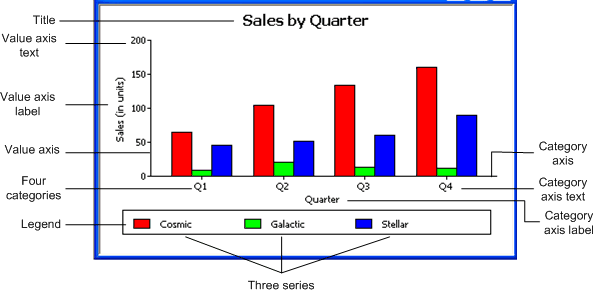Here is a column graph created in PowerBuilder that contains most major parts of a graph. It shows quarterly sales of three products: Stellar, Cosmic, and Galactic printers:
Graphs display data points. To define graphs, you need to know how the data is represented. PowerBuilder organizes data into three components.
|
Component |
Meaning |
|---|---|
|
Series |
A set of data points Each set of related data points makes up one series. In the preceding graph, there is a series for Stellar sales, another series for Cosmic sales, and another series for Galactic sales. Each series in a graph is distinguished by color, pattern, or symbol. |
|
Categories |
The major divisions of the data Series data are divided into categories, which are often non-numeric. In the preceding graph, the series are divided into four categories: Q1, Q2, Q3, and Q4. Categories represent values of the independent variable(s). |
|
Values |
The values for the data points (dependent variables). |
The following table lists the parts of a typical graph.
|
Part of graph |
What it is |
|---|---|
|
Title |
An optional title for the graph. The title appears at the top of the graph. |
|
Value axis |
The axis of the graph along which the values of the dependent variable(s) are plotted. In a column graph, as shown in the preceding graph, the Value axis corresponds to the y axis in an XY presentation. In other types of graphs, such as a bar graph, the Value axis can be along the x dimension. |
|
Category axis |
The axis along which are plotted the major divisions of the data, representing the independent variable(s). In the preceding graph, the Category axis corresponds to the x axis. It plots four categories: Q1, Q2, Q3, and Q4. These form the major divisions of data in the graph. |
|
Series |
A set of data points. There are three series in the preceding graph: Stellar, Cosmic, and Galactic. In bar and column charts, each series is represented by bars or columns of one color or pattern. |
|
Series axis |
The axis along which the series are plotted in three-dimensional (3D) graphs. |
|
Legend |
An optional listing of the series. The preceding graph contains a legend that shows how each series is represented in the graph. |



